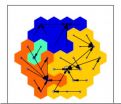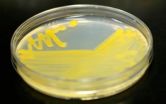(Press-News.org) Grand Rapids, Mich. (January 19, 2011) – In a collaborative project involving scientists from three continents, researchers have identified a gene that is mutated in one in three patients with the most common form of renal cancer. The gene – called PBRM1 – was found to be mutated in 88 cases out of 257 clear cell renal cell carcinomas (ccRCC) analysed, making it the most prevalent to be identified in renal cancer in 20 years.
The identification of a frequently mutated gene provides new insights into the biology of the disease, which will be critical in the continued effort to improve treatment for renal cancer. The study, published today in the journal Nature, was carried out by researchers from the Wellcome Trust Sanger Institute (UK), the National Cancer Centre of Singapore, and Van Andel Research Institute (VARI) of Grand Rapids, Michigan.
Renal cancer is among the 10 most common cancers in both men and women in the United States, striking nearly 60,000 Americans in 2010, and killing more than 13,000, according to the National Cancer Institute.
Renal cell carcinoma (RCC) accounts for 9 out of 10 kidney cancers, and ccRCC is the most common subtype, accounting for 8 out of 10 RCC cases. Survival rates for early-detected ccRCC tumors can be as high as 95 percent, but that prognosis falls over time as tumors develop. Diagnosis is complicated by the fact that tumors can grow in the kidney for some time without presenting symptoms.
For many years, the main genetic determinant known to be involved in the development of renal carcinoma was mutation of the VHL gene on chromosome 3.
"Until recently, when we talked about the genetics of renal carcinoma we would inevitably be talking about VHL – a gene mutated in eight out of ten patients," said Dr. Andy Futreal, Head of Cancer Genetics and Genomics and co-Head of the Cancer Genome Project at the Wellcome Trust Sanger Institute. "But we knew this was likely not to be the full story – so the question we have sought to answer is which genes are conspiring with VHL to cause the disease we see in patients?"
"Over the last year or so, we have started to assemble that puzzle – this research provides a new and critical piece."
The team's recent work had previously identified three mutated genes associated with renal cancer. These genes are all involved in altering part of the scaffold – known as chromatin – that holds the DNA together in our cells and can influence gene activity.
"Our understanding of how kidney cancer develops had already markedly improved through identification of three new mutated cancer genes, each of which makes a small contribution to the disease" said Professor Mike Stratton, Director of the Sanger Institute and co-Head of the Cancer Genome Project. "Now, our discovery of PBRM1 mutations in one in three kidney cancers is a major advance. We think we may have an almost complete understanding of the set of abnormal genes that drive this cancer and our understanding of the disease has been transformed by the realisation that most of these genes are involved in providing the structure that encases DNA in the cell and that regulates its function. This insight will provide us with many new therapeutic directions for this cancer."
Much of the story, the researchers suggest, seems to be locked into a small region of chromosome 3. The study finds that PBRM1(also known as Baf180) is tied together with two previously identified renal cancer genes – including the well-established VHL cancer gene and the recently identified gene SETD2 – on a small region of chromosome 3.
The team suggests that the fact that the genes are linked in their location allows cancer to exploit our biology – by reducing the number of genetic events needed to hit and inactivate all three genes. The team found a significant level of overlap, with many patients carrying mutations in two, if not all three of the genes in this region.
"This study has begun to unlock the way these latest gene discoveries contribute to cancer," said Professor Bin Tean Teh, M.D., Ph.D., Head of the Van Andel Research Institute Laboratory for Cancer Genetics and the NCSS-VARI Translational Research Laboratory at the National Cancer Centre of Singapore. "And it is to the cancer's advantage that they sit together. The challenge for the future will be to build a picture of the processes the genes control. That will mean looking beyond the linear DNA code to the chemical interactions that take place at the structural level – at the level of the chromosome."
Importantly, the newly discovered gene, PBRM1, functions as part of a protein complex called SWI-SNF, which also acts to alter the structure of chromatin – further pointing to the importance of genome regulation in renal cancer.
"Our work provides evidence that PBRM1 may affect the processes of cell division in renal cells. Therefore, a defect in this gene could lead to abnormal cellular growth," said Kyle Furge, Ph.D., Head of VARI's Laboratory of Computational Biology. "For researchers, this discovery is exciting because PBRM1 is a protein that modifies the DNA in the cell. This study is one of the first to show that proteins that modify DNA are frequently mutated in cancer."
The mutations all appear to inactivate a protein that plays a role in remodelling the structure of the genetic material, allowing access of the DNA code to other proteins that can repair damage, control cell growth and turn other genes on and off.
In addition to the PBRM1 mutations, the team also found mutations in a gene called ARID1A in some ccRCC cases. The same gene was identified just weeks ago in clear cell ovarian cancer. The researchers suggest that further larger-scale research will be needed to understand what role this second gene plays in renal cancer.
###
Notes to Editors
Publication Details
Varela I et al. (2010) Exome sequencing identifies frequent mutation of the SWI/SNF complex gene PBRM1 in renal carcinoma. Nature.
Published online before print at doi: 10.1038/nature09639
Funding
This work was supported by the Wellcome Trust, the Van Andel Research Institute, the Lee Foundation, Cancer Research UK, the University of Cambridge and a fellowship from The International Human Frontier Science Program Organization.
Participating Centers
Cancer Genome Project, Bioinformatics and Experimental Cancer Genetics, Wellcome Trust Sanger Institute, Hinxton, UK
NCCS-VARI Translational Research Laboratory, National Cancer Centre Singapore, Singapore
Masonic Cancer Center, University of Minnesota, Minneapolis, USA
Bioinformatics and Statistics, Department of Molecular Biology, The Netherlands Cancer Institute, Amsterdam, The Netherlands
Génétique Oncologique EPHE-INSERM U753, Faculté de Médecine Paris-Sud and Institut de Cancérologie Gustave Roussy, 94805 Villejuif and Centre Expert National Cancer Rares INCa "PREDIR", Service d'Urologie, Hôpital de Bicêtre, AP-HP, 94276 Le Kremlin- Bicêtre, France
Department of Urology, Spectrum Health Hospital, Grand Rapids, Michigan, USA
Li Ka Shing Centre, Cambridge Research Institute, Cancer Research UK, Robinson Way, Cambridge, UK
Institut für Theoretische Physik, Universität zu Köln, Köln, Germany
Laboratory of Computational Biology and Laboratory of Cancer Genetics at Van Andel Research Institute, Grand Rapids, Michigan, USA
Laboratory of Cancer Therapeutics, DUKE-NUS Graduate Medical School, Singapore
Institute of Cancer Research, Sutton, Surrey, UK
The National Cancer Centre Singapore (NCCS) is at the forefront of cancer treatment and research. It offers its patients hope by providing the best care, by having the best people and by doing the best research. Designed to provide integrated and holistic patient-centred clinical services, it allows crossconsultation among oncologists of different specialities. Its holistic approach not only provides comprehensive multi-disciplinary cancer care but also develops public cancer education programmes and spearheads cutting-edge clinical and translational research in the understanding, prevention, diagnosis and treatment of cancer.
http://www.nccs.com.sg/
About Van Andel Institute
Established by Jay and Betty Van Andel in 1996, Van Andel Institute (VAI) is an independent research and educational organization based in Grand Rapids, Mich., dedicated to preserving, enhancing and expanding the frontiers of medical science, and to achieving excellence in education by probing fundamental issues of education and the learning process. VARI, the research arm of VAI, is dedicated to probing the genetic, cellular and molecular origins of cancer, Parkinson and other diseases and working to translate those findings into effective therapies. VARI is affiliated with the Translational Genomics Research Institute, (TGen), of Phoenix, Arizona.
http://www.vai.org
The Wellcome Trust Sanger Institute, which receives the majority of its funding from the Wellcome Trust, was founded in 1992. The Institute is responsible for the completion of the sequence of approximately one-third of the human genome as well as genomes of model organisms and more than 90 pathogen genomes. In October 2006, new funding was awarded by the Wellcome Trust to exploit the wealth of genome data now available to answer important questions about health and disease.
http://www.sanger.ac.uk
The Wellcome Trust is a global charitable foundation dedicated to achieving extraordinary improvements in human and animal health. We support the brightest minds in biomedical research and the medical humanities. Our breadth of support includes public engagement, education and the application of research to improve health. We are independent of both political and commercial interests.
http://www.wellcome.ac.uk
Research provides new kidney cancer clues
Gene mutated in 1 in 5 patients with common form of renal cancer
2011-01-20
ELSE PRESS RELEASES FROM THIS DATE:
Mathematical model explains how complex societies emerge, collapse
2011-01-20
The instability of large, complex societies is a predictable phenomenon, according to a new mathematical model that explores the emergence of early human societies via warfare. Capturing hundreds of years of human history, the model reveals the dynamical nature of societies, which can be difficult to uncover in archaeological data.
The research, led Sergey Gavrilets, associate director for scientific activities at the National Institute for Mathematical and Biological Synthesis and a professor at the University of Tennessee-Knoxville, is published in the first issue of ...
Roundworm unlocks pancreatic cancer pathway
2011-01-20
Chapel Hill, NC – The National Cancer Institute estimates that more than 43,000 Americans were diagnosed with pancreatic cancer last year and more than 36,000 died from the disease. Despite advances in genetic science showing that the Ras oncogene is mutated in virtually all pancreatic cancers, scientists have been frustrated by the complexity of the signaling pathways in humans, which make it difficult to pinpoint potential therapeutic targets.
In a study published today in the Cell Press journal Developmental Cell, a team of researchers led by Channing Der, PhD, Distinguished ...
Speeding up Mother Nature's very own CO2 mitigation process
2011-01-20
LIVERMORE, Calif. – Using seawater and calcium to remove carbon dioxide (CO2) in a natural gas power plant's flue stream, and then pumping the resulting calcium bicarbonate in the sea, could be beneficial to the oceans' marine life.
Greg Rau, senior scientist with the Institute of Marine Sciences at UC Santa Cruz and who also works in the Carbon Management Program at Lawrence Livermore National Laboratory, conducted a series of lab-scale experiments to find out if a seawater/mineral carbonate (limestone) gas scrubber would remove enough CO2 to be effective, and whether ...
Science Translational Medicine: 'Creating Hope Act' incentivizes pediatric drug R&D
2011-01-20
Washington, DC — Recent legislative and regulatory actions make great strides toward establishing much needed incentives for pharmaceutical companies and others to develop and test more medications for pediatric rare diseases, including pediatric cancers, according to commentary by experts from Children's National Medical Center. The commentary appears in the January 19 issue of Science Translational Medicine.
"Pediatricians who treat children with serious and life-threatening diseases often find themselves face to face with the inadequacies of pediatric drug development," ...
Small molecules may prevent ebola infection
2011-01-20
Ebola, a virus that causes deadly hemorrhagic fever in humans, has no known cure or vaccine. But a new study by University of Illinois at Chicago scientists has uncovered a family of small molecules which appear to bind to the virus's outer protein coat and may inhibit its entry into human cells.
The results are to be published in the Journal of Medicinal Chemistry and are now online.
Previous studies have shown that small molecules can interfere with the Ebola infection process, says Duncan Wardrop, associate professor of chemistry at UIC and corresponding author of ...
Like humans, amoebae pack a lunch before they travel
2011-01-20
Some amoebae do what many people do. Before they travel, they pack a lunch.
In results of a study reported today in the journal Nature, evolutionary biologists Joan Strassmann and David Queller of Rice University show that long-studied social amoebae Dictyostellum discoideum (commonly known as slime molds) increase their odds of survival through a rudimentary form of agriculture.
Research by lead author Debra Brock, a graduate student at Rice, found that some amoebae sequester their food--particular strains of bacteria--for later use.
"We now know that primitively ...
University of Illinois study confirms glycerin as a feasible feedstuff for swine
2011-01-20
An increased interest in biofuel production and a growing need to find cost-effective livestock feedstuff alternatives has led University of Illinois researchers to further evaluate the use of glycerin in swine diets.
This study, led by U of I graduate research assistant Omarh Mendoza, was published in the Journal of Animal Science and reports that swine diets may include up to 15 percent glycerin and achieve similar performance to a conventional corn:soybean diet.
"Glycerin is not a new product, but little is known about its role as a feed ingredient for swine," ...
A nanoscale rope, and another step toward complex nanomaterials that assemble themselves
2011-01-20
Scientists at the U.S. Department of Energy's Lawrence Berkeley National Laboratory (Berkeley Lab) have coaxed polymers to braid themselves into wispy nanoscale ropes that approach the structural complexity of biological materials.
Their work is the latest development in the push to develop self-assembling nanoscale materials that mimic the intricacy and functionality of nature's handiwork, but which are rugged enough to withstand harsh conditions such as heat and dryness.
Although still early in the development stage, their research could lead to new applications that ...
US Office of Naval Research achieves milestone
2011-01-20
VIDEO:
This is the Free Electron Laser video.
Click here for more information.
ARLINGTON, Va.-Scientists at Los Alamos National Lab, N.M., have achieved a remarkable breakthrough with the Office of Naval Research's Free Electron Laser (FEL) program, demonstrating an injector capable of producing the electrons needed to generate megawatt-class laser beams for the Navy's next-generation weapon system.
The Dec. 20 milestone, which occurred months ahead of schedule, will be the ...
Investing into Frontier Markets has become easier
2011-01-20
UK-based Veritas Financial Europe announces the official launch of the new information platform for investors - FrontiersInsight.com. This web-based platform is designed for both private as well as institutional investors that have substantial interest in investing into new, previously unexplored Frontier markets with huge upside potential. The unique tools offered by FrontiersInsight will also be useful for brokerage and investment firms, VC and PE companies, research and statistical centers.
The platform covers more than 13,000 public and private companies in developing ...
LAST 30 PRESS RELEASES:
Research validates laboratory model for studying high-grade serous ovarian cancer
SIR 2026 delivers transformative breakthroughs in minimally invasive medicine to improve patient care
Stem Cell Reports most downloaded papers of 2025 highlight the breadth and impact of stem cell research
Oxford-led study estimates NHS spends around 3% of its primary and secondary care budget on the health impacts of heat and cold in England
A researcher’s long quest leads to a smart composite breakthrough
Urban wild bees act as “microbial sensors” of city health.
New study finds where you live affects recovery after a hip fracture
Forecasting the impact of fully automated vehicle adoption on US road traffic injuries
Alcohol-related hospitalizations from 2016 to 2022
Semaglutide and hospitalizations in patients with obesity and established cardiovascular disease
Researchers ‘listen in’ to embryo-mother interactions during implantation using a culture system replicating the womb lining
How changing your diet could help save the world
How to make AI truly scalable and reliable for real-time traffic assignment?
Beyond fragmented markets: A new framework for efficient and stable ride-pooling
Can shape priors make road perception more reliable for autonomous driving?
AI tracks nearly 100 years of aging research, revealing key trends and gaps
Innovative techniques enable Italy’s first imaging of individual trapped atoms
KIER successfully develops Korea-made “calibration thermoelectric module” for measuring thermoelectric device performance
Diversifying US Midwest farming for stability and resilience
Emphasizing immigrants’ deservingness shifts attitudes
Japanese eels, climate change, and river temperature
Pusan National University researchers discover faster, smarter heat treatment for lightweight magnesium metals
China’s 2024 Gastroenterology Report: marked progress in endoscopy quality and disease management
Pusan National University researchers uncover scalable method for ultrahigh-resolution quantum dot displays
Researchers use robotics to find potential new antibiotic among hundreds of metal complexes
Gut bacteria changes at the earliest stages of inflammatory bowel disease
Scientists develop new way to “listen in” on the brain’s hidden language
Brain research: “Pulse generators” grow and shrink as memories are formed
For teens, any cannabis use may have impact on emotional health, academic performance
School meals could unlock major gains for human and planetary health
[Press-News.org] Research provides new kidney cancer cluesGene mutated in 1 in 5 patients with common form of renal cancer


